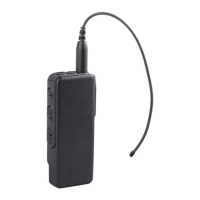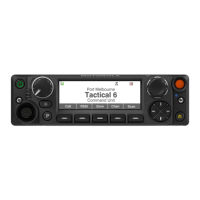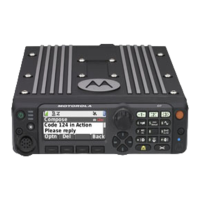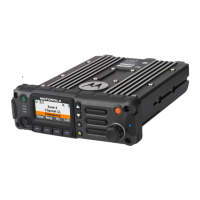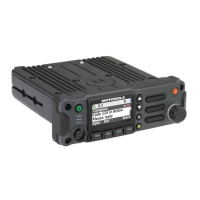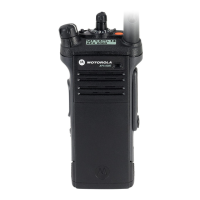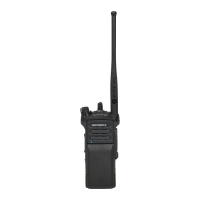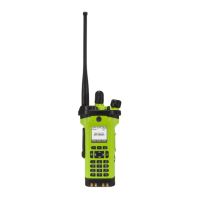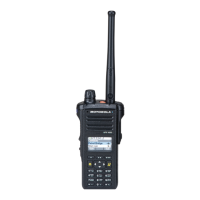February 14, 2012 6816985H01-F
4.4-16 700/800 MHz Detailed Theories of Operation: VOCON Functional Blocks
The Patriot determines a key press by a scanning algorithm. Each column line is configured as an
open drain output and pulled low. The Patriot then scans the row pins (each row pin has an internal
pull up resistor). If a row signal is read low, then the Patriot determines that a key was pressed. If
none of the row signal lines are low, then another column line is pulled low and the row scanning
routine occurs.
The Patriot GPIO BL_EN controls the keypad backlighting; that signal goes to pin 43 of the J601
connector (on the radio board), and the corresponding pin 3 of the J901 connector (on the Option
board). Pin 42 is supplied with 7.5 volts, which is used to power the LEDs on the keypad module.
4.4.6.3.5 Encryption Module
The encryption module (secure models only) connects directly to the VOCON board and interfaces
directly with the vocoder digital circuitry. It contains one custom microcontroller IC (Armour) to
perform digital, numerical, encryption algorithms.
The encryption modules are designed to digitally encrypt and decrypt voice for ASTRO and
NON-ASTRO in XTS 2500/XTS 2500
I/XTS 2000/ATS 3000. This section covers the encryption
modules, hardware kits 0104020J49 (Model 1.5), 0104020J50 (Model 2) and 0104020J51 (Model
3).
NOTE: The encryption modules are NOT serviceable. The information contained in this section is
only intended to help determine whether a problem is due to an encryption module or the radio
itself.
The encryption module uses a custom encryption IC and an encryption key variable to perform its
encode/decode function. The encryption key variable is loaded into the encryption module, via the
radio's universal (side) connector, from a hand-held, key variable loader (KVL). The encryption IC
corresponds to the particular encryption algorithm purchased. Table 4.4-2 lists the encryption
algorithms and their corresponding kit numbers.
The encryption module operates from two power supplies (UNSW_B+ and SW_B+). The SW_B+ is
turned on and off by the radio's On/Off switch. The UNSW_B+ provides power to the encryption
module as long as the radio battery is in place.
Key variables are loaded into the encryption module through connector J601, pin 34. Depending on
the type of encryption module, up to 16 keys can be stored in the module at a time. The key can be
infinite key retention or 30-seconds key retention, depending on how the codeplug is set up.
The radio' s host processor communicates with the encryption module on the Synchronous Serial
Interface (SSI) bus. The SSI bus consists of four signal lines. A communications failure between the
host processor and the secure module will be ERROR 09/10 or S03 error message on the display.
To troubleshoot the encryption module, refer to the flowcharts in Chapter 6.4 “700/800 MHz
Troubleshooting Charts.”
Table 4.4-2. Encryption Module Software Kits and Algorithms
Software
Kit Number
Algorithm
Q667AB (7/
800), Q667AE
(V,U1,U2)
ADP SFWR DSP BASED CRYPTO
Q159AC XTS 2500/XTS 2500
I/XTS 2000/ATS 3000 UCM HARDWARE ENCRYPTION
Q629AD AES ENCRYPTION

